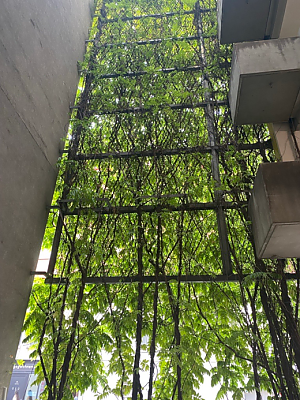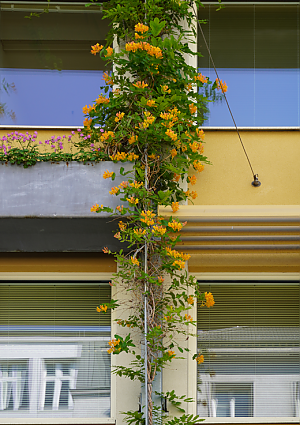Climbing plant NAVI - Webapplication for the reliable selection of climbing plants
Short Description
Starting point / motivation
Increasing sealing of surfaces and the consequences of climate change are leading to so-called urban heat islands (UHI). The temperatures of asphalted surfaces can reach up to 60°C. It is particularly stressful when there is also no cooling at night. The Austrian UHI risk index shows that 60-80% of urban areas are exposed to high heat stress.
In addition to trees, green spaces, running water and green facades help to reduce overheating. Climbing plants also provide cooling through evaporation in densely built-up areas, lower the ambient temperature and reduce heat radiation from walls. When selecting suitable climbing plants, there are several parameters to consider, that are currently difficult or impossible to find in various lists and specialist literature.

Contents and goals
When selecting climbing plants for greening projects, numerous factors must be considered. These include the location, water and light conditions, the type of façade for building greening, as well as the thickness growth, weight of the plants. Toxicity and the choice of a suitable trellis also play an important role.
All these aspects are crucial to ensure the sustainable success of the greening project and to avoid damage to the building fabric. In addition, the selection of plants needs to be adapted to climate change, for which provision must be made no.
Due to the large number of factors to be considered, selecting the right climbing plant for a location is a complex undertaking that requires in-depth knowledge. This is difficult to handle with conventional lists, pictures and books, which are often not easily accessible. In the comprehensive search for suitable climbing plants, several sources of information must be combined, resulting in high personnel resources and planning costs.
The climbing plant navigator will be developed (in German and English) and integrates parameters such as the type of greening, weight classes, toxicity, ecological value, the possibility of culinary use and the type of trellis required on a web application. In addition, the information is visualized with illustrative pictures.

A database of climbing plants is being set up which contains all the relevant parameters and has filter functions. At least 50 native and non-native plants are to be recorded, covering all areas of application (with a focus on climate-fit plants). The climbing plant navigator is intended to reach municipal representatives, specialists, planners, architects and private individuals. A division into different categories is planned in order to be able to adapt the filter criteria according to the areas of application.
Methods
Comprehensive literature and online research provide an important data basis. Focus groups with experts and stakeholder workshops are used to identify all requirements for the web application and validate the underlying data. Through feedback loops, we ensure a user-friendly, practical tool that can be used by a wide range of people, such as private individuals, landscape planners, decision-makers, cities and municipalities. Once the tool has been programmed, it will be tested and made available in both German and English.
Expected results
The climbing plant navigator is intended to contribute to increasing biodiversity in urban areas by simplifying the selection of plants. The web application should be publicly accessible and barrier-free. The development process will be optimized with an iterative process in which feedback from users is continuously incorporated into the development.
The new CLIMBSHOW dissemination format offers a new and innovative way of activating communities and imparting knowledge about measures to adapt to climate change and promotes the implementation of more green façades. Dissemination includes cooperation with existing institutions, such as KLAR regions and the European Green Building Association, to spread the new web application.
Project Partners
Project management
GRÜNSTATTGRAU Forschungs- und Innovations- GmbH
Project or cooperation partners
"Natur im Garten"
Contact Address
DI Susanne Formanek
Favoritenstraße 50
A-1040 Vienna
Tel.: +43 (650) 634 96 31
E-mail: office@gruenstattgrau.at
Web: www.gruenstattgrau.at
